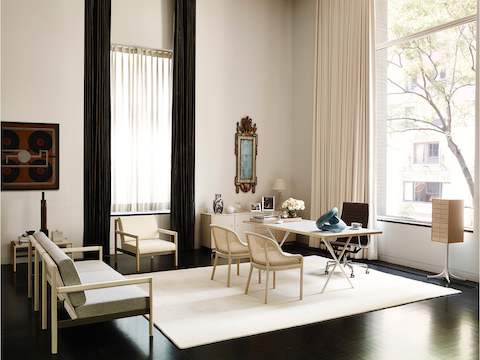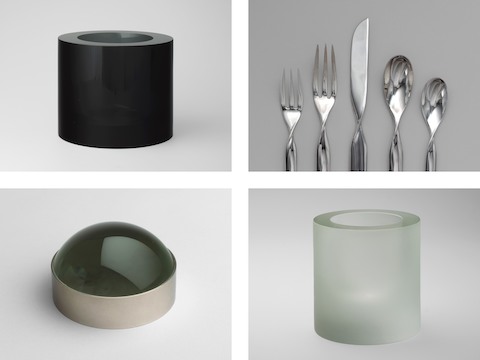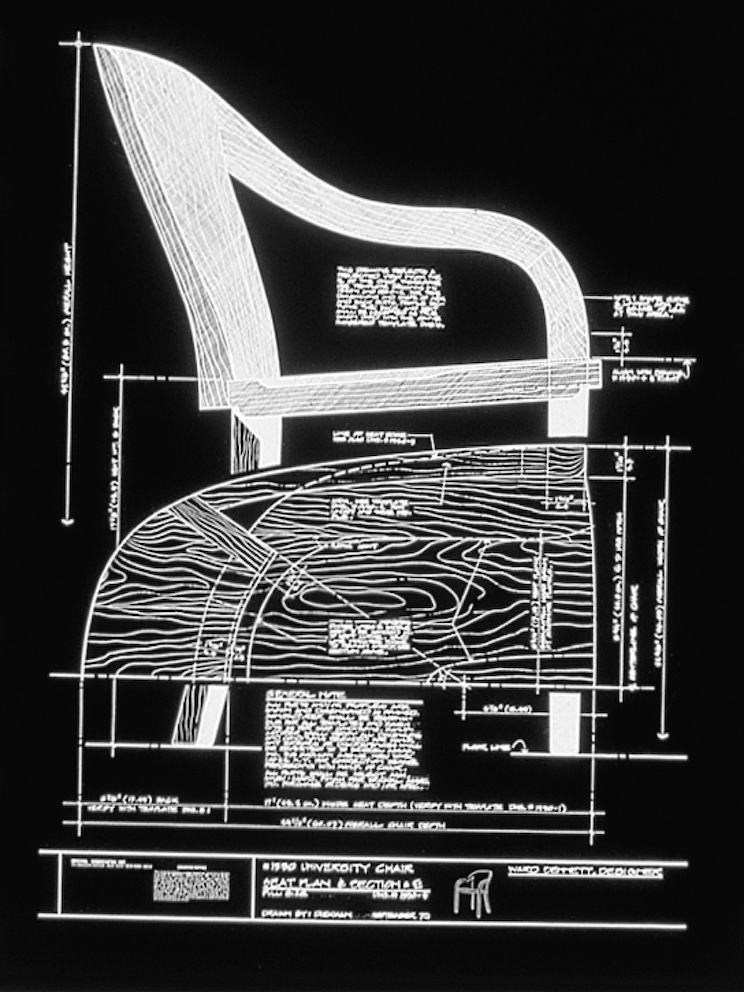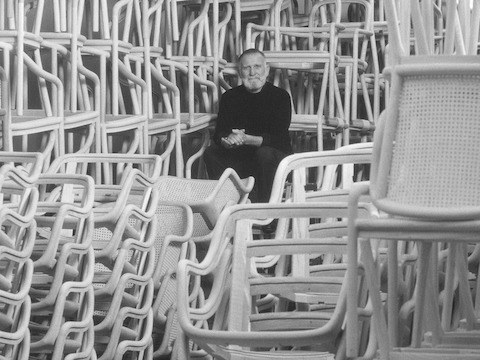When Ward Bennett died in 2003 at the age of 85, the New York Times described him as “a New York designer of furniture, houses and much more, whose clean lines and exquisite materials quietly defined an era.” During a career that spanned over five decades, Bennett designed everything from jewelry and flatware, to chairs and houses. A master of functional simplicity, his fundamental philosophy was that “in life and design, try to pull it all down to a minimum.” Yet a decade after his death, there are no monographs of his work, and though acclaimed as a great American designer—at the height of his career in the 1980s, he received a medal from the American Institute of Architects, and he graced the covers of Metropolis and Interiors magazines—he never became a household name.
Bennett was born in 1917 and grew up in Washington Heights, in Upper Manhattan. His father was an actor-vaudeville performer, his mother a tightrope walker, and the family zigzagged across the country, from Saratoga and Miami to Maryland and California. “There was no culture in the home at all,” Bennett recalled, in an early interview. “I mean vaudeville was about it. When I was growing up, I only remember once or twice seeing my father perform. When talkies came in he was out of work and he never made it, so we lived rather raggedly and moved around a lot….There were some family problems and it was either he or I got out.”

Bennett loved working with flexible, linear materials such as reed—“you get a lovely sweep from reed”—to achieve the graceful lines that are characteristic of his furniture. (His classic 1964 Landmark chair, above, is once again available with a cane back. Photo by François Dischinger.
After leaving home at 13, Bennett found a job as a delivery boy in New York’s ladies’ silk lingerie industry, and began taking a few night classes in fashion sketching, eventually landing a job sketching for the fashion designer Jo Copeland, making 75 dollars a week. At 14, he was working at Saks Fifth Avenue making sketches for bridal gowns, and two years later, he was riding the Queen Mary to France as an assistant for a firm called Joe and Junior (they specialized in styles for teenagers) to sketch the couture collections in Paris. “I was so frightened that I fell down the steps of the first-class dining room right into the Crêpes Suzettes,” he said. “I was wearing my first dinner jacket—really, it was one I had borrowed from a waiter.”
After a stint in the Army during World War Two, he returned to New York, and got a job window dressing and designing furs for Hattie Carnegie, a well-known fashion designer whose clients included Joan Crawford and the Duchess of Windsor. He studied by night with the abstract expressionist painter Hans Hofmann—“He’d set up a still life, and we would all draw it in black and white charcoal,” said Bennett. “This was merely to explore the tensions within that space. What pushed forward, what came toward you. Basically his big thought, his love, his poetry, was space; what was happening in space. And I’ve been dealing with that ever since.”
He returned to Paris on the G.I. Bill to study sculpture briefly with Ossip Zadkine. (Bennett didn’t like his work at all: “It was too intellectual.”) There, he met one of his heroes, the Parisian sculptor Constantin Brancusi, who made a lasting impression. “His studio was like heaven; it was a dream,” said Bennett. “Brancusi had a kind of honesty and integrity, a genius, that made me decide against becoming a sculptor at that moment.” He also became acquainted with the architect, painter, and theorist Le Corbusier, and began to look seriously at modern architecture and its relationship to interiors and decoration.
In 1946, Bennett traveled to Mexico and spent a year with the artist Lydia Modi, designing modernist jewelry that was later exhibited at the Museum of Modern Art. Through his friendship with the designer Benjamin Baldwin, he worked on the interiors of Terrace Plaza Hotel in Cincinnati—an important early International Style modern hotel by Skidmore, Owings and Merrill, which was so advanced in its design, aesthetics, and technology that it was jokingly called “the pushbutton palace.” The hotel had the world’s first “sky lobby,” in addition to stunning interiors, which featured modern art including an Alexander Calder mobile and murals by Saul Steinberg and Joan Miró. (Bennett’s light sconces, installed in the Gourmet Lounge, were hand-forged, hand-cut brass disks that had uncomplicated cutouts that recalled Chinese art).

For the design of Mirella and Robert Haggiag's New York apartment, Ward Bennett kept everything below window height to preserve the views of Central Park. Photo by Dean Kaufman.
Bennett’s big break, however, came in 1947 when he designed his first interior commission—the penthouse apartment for Mr. and Mrs. Harry Jason (his sister-in-law’s sister), which combined expertly the family’s Biedermeier antiques with contemporary furniture and paintings framed in a monotone palette of deep-to-pale grey. Bennett’s fashion background helped him define what elegance was, and his training in window display gave him the confidence to select and work with objects of quality and arrange everything in the proper lighting. When the project was published in the New York Times, it was described as “a modern success story,” and Bennett began to make a name for himself as an interior designer who employed a minimalist style—which, at the time, was described by the newspaper as “under-furnishing.”
In a 1951 profile of Bennett in Interiors magazine, the editor Olga Gueft describes the designer as “a medium-sized, tightly knit man with broad shoulders….He is dressed in faded army khaki with rolled-up sleeves, but so well pressed that it does not look in the least casual. His eyes, which are very blue, and boyish, crinkle constantly with good-natured enthusiasm, but in repose are earnest, aware, and extremely attentive. The large forehead and prominent nose are sunburned, and the sun has bleached the eyebrows several shades lighter than the crew-cut hair which covers the head like a brown brush.”
Bennett’s apartment on East 72nd in Manhattan during the early 1950s combined built-in teak furniture with antique English Regency library chairs, Chinese scroll-painting, and clamped-on green glass lampshades from an old-time watch-maker’s shop helped create a spare, uncluttered feeling. Bennett was one of the earliest American designers to pioneer the use of the conversation pit, his way of eliminating furniture clutter, in addition to adapting industrial materials and equipment in the home. He specified subway grating to mask radiators and a hospital dolly for a drinks table in addition to other off-the-shelf components ordered from industrial catalogs, well before the high-tech look became popular in the 1970s.
Bennett’s minimalist philosophy came from a variety of interests, from visiting the homes and studios of Brancusi (“To see far is one thing; to get there is another” was one of Bennett’s favorite quotes from the sculptor) and Le Corbusier, to the ideas of Zen Buddhism and the writings of Montaigne, Walt Whitman, and Henry Thoreau—“Our life is frittered away by detail…simplify, simplify,” was another favorite Bennett quote.
“Bennett was one of the earliest American designers to pioneer the use of the conversation pit, his way of eliminating furniture clutter, in addition to adapting industrial materials and equipment in the home. He specified subway grating to mask radiators and a hospital dolly for a drinks table in addition to other off-the-shelf components ordered from industrial catalogs, well before the high-tech look became popular in the 1970s.”

A number of pieces from Ward Bennett's portfolio are part of the permanent collection at MoMA, including a variety of tabletop objects. Clockwise from top left: a black crystal vase for Salviati & C, 1965; stainless steel Double Helix Flatware for Sasaki, Japan, 1985; A lens glass and nickel paperweight for Hermes, 1955; a crystal vase for Salviati & C, 1960. © The Museum of Modern Art/Licensed by SCALA / Art Resource, NY
Bonnie Mackay, Principal of BMackay Consulting, and the former fashion director for tableware at Bloomingdale’s, collaborated with Bennett to create several iconic tabletop and flatware collections during the 1980s. She describes Bennett as a tireless explorer who taught her to be one also. “Ward taught me that a good design is timeless,” she says. “And that it was so much more important to look deeply into a design and its form—how eloquent it looks, and how one detail in an object can affect a completely different one. He would have me close my eyes and feel an object with my fingertips and how a fork balanced in my hand.” He also believed that models in different materials and scales must be made to confirm if a design will work, before submitting it for production consideration.
It was Bennett’s commission through the architect Armand Bartos to do the Crown Zellerbach’s New York midtown offices that inspired him to design his first collection of custom-made furniture for the Lehigh Furniture Company. Bennett felt it was an ego thing: “Why should I buy in some wholesale warehouse? Why not do it yourself? It’s so simple.” In 1964 he began to collaborate with Brickel Associates, designing furniture, textiles, and some lighting, and in 1987, he began working with Geiger International, which still produces his furniture today. Altogether he designed more than 150 chairs in his career.
When a back injury suffered while skiing left Bennett hospitalized, Bennett began to think more about how a chair design should be based on supporting human anatomy, not simply on the style and context of where the chair will be used. He worked with specialists like Dr. Howard Rusk who helped him, through exercise, to solve his lower lumbar problem, and Dr. Janet Travell—who also treated John F. Kennedy’s bad back—and who taught the designer how to sit correctly and what to look for in a chair. (She advocated a short seat with the support of the lower lumbar region.) “I learned it is best to sit back into the chair, that is, to sit in and not on a chair, and also there should be arms on the chair,” he once stated. “I believe arms are second in importance only to proper lumbar support.” For anyone interested in designing chairs, Bennett believed it should start with the pitch, that ideal angle between the slant of a chair’s back and its seat that insures firm support for the lower back.
As a designer, Bennett was an adaptive evolutionist, who preferred to look at traditional typologies—be it a Bentwood chair or an eighteenth-century French design—as a starting point, and improving them. His iconic Scissor chair, designed in 1968, for example, was based on using the pitch of a nineteenth-century Brighton Beach chair, which he owned and admired. It was a technique he often used, to select a chair he found comfortable, take a pattern of the pitch, and then make a simplified version, always preferring natural materials—wood, leather, hand woven and hand-dyed fabrics.
“Ward taught me that a good design is timeless, and that it was so much more important to look deeply into a design and its form—how eloquent it looks, and how one detail in an object can affect a completely different one. He would have me close my eyes and feel an object with my fingertips and how a fork balanced in my hand.”
- Bonnie Mackay

An early sketch for Bennett's University Chair, which reflects his start in fashion as a pattern maker.
Bennett drew upon his fashion background as a pattern maker, preferring to design a chair by working directly on a cardboard armature. For this reason, he loved working with flexible, linear materials such as reed—“you get a lovely sweep from reed”—to achieve the graceful lines that are characteristic of his furniture. (His classic 1964 Landmark chair, with a sculptural quality expressed through the exposed wood frame, is once again available with a cane back.) “Starting with the pitch, I then work with muslin, a staple gun and cardboard,” Bennett explained. “Say, for instance, I wanted to make a lower chair into a high-back chair. I would take a couple of strong photographic clips and a huge piece of cardboard, and clip it on. And then I would start drawing on the cardboard to get the shape. It’s an armature—no different from sculpture, or even making dresses.”
The design for Bennett’s 1979 Shellback chair was similarly culled from various references and combined the natural imagery of a shell with nods to Art Nouveau and Josef Hoffmann, and was upholstered in a hand-sewn, channel-backed leather or fabric. During the mid-1970s, when desks where being stripped down to a drawer-less table-desk, Bennett turned to the luxurious era of the Art Deco as a way of restoring some old-fashioned ideals into the form. (He included a kneehole and a bank of drawers on either side for a desk he launched in 1977.) The sophisticated Rolled Arm Sofa, with its solid form and crisp upholstery, lends an almost sculptural presence to any space, and the popular Bumper chair, for example, designed in 1964 and now reissued by Geiger, is based on the George Washington swivel chair, with its short bucket seat, nice sweep, and good lumbar support. “Chairs should be short in the seat,” Bennett stated, “because then the feet rest on the floor and pressure is removed.”
Taking inspiration from everything from an evening dress by the fashion designer Madeleine Vionnet or Claude-Nicholas Ledoux’s eighteenth-century gates of Paris, to the Temple of Horus in Egypt or a Victorian leather chair, Bennett believed well-designed and well-constructed furniture of all periods could co-exist happily side-by-side. “I do not know why one should eliminate the past,” he stated. “Any mixture is possible as long as each piece is good. It is just as right to have English eighteenth-century furniture as it is to have pre-Columbian sculptures—provided they are both beautiful or basically contribute to the total environment….We should be able to use old, good pieces as part of our design vocabulary, within a modern background of design.” And by simplifying the lines of historical pieces, he was able to transform them into truly original works.

Based on George Washington's iconic, 18th-century swivel chair, the design for Bennett's Bumper Chair (pictured above) is once again available through Geiger. Photo by François Dischinger.
Bennett believed that objects or furnishings in a room must have a cultural validity to be design elements. “They are not simply what people go out and buy; they must have a meaning for the interior and for the client,” he stated. “Putting up a picture is not just decorating; its placement is a spatial concept. If a picture is properly hung in a room, it is necessary element without which the interior design would be incomplete.”
Mackay still remembers Bennett as someone who was focused and fearless: “His taste was superb,” she says. “I saw it in every detail of his life, from his home, his clothing, his food, and, of course, his designs. He mentored me and ushered me into his world of design and taught me to appropriate the most simple eloquent design that can be found anywhere—from a dragonfly to canvas on a sail.”
Despite tireless dedication to his craft, Bennett believed ultimately that the way one lived was far more valuable than how one made his living. In his own life, he preferred a quiet, existence. When he wasn't working, he spent half of his time in the country, gardening, designing, and working with ceramics, and spending time travelling. “All this doesn’t require a lot of money,” he said. “I’ve always done it.” For a designer steeped in high-end luxury, and the business of adding value to people’s aesthetic experience, he always saw the distinction between work and life clearly. “I design interiors, and furniture, and flatware, and so forth,” he said in a 1981 interview with Barbaralee Diamonstein-Spielvogel. “But I think the way I live is maybe the most meaningful.”
Paul Makovsky is the editorial director of Metropolis magazine. He is currently working on a book about the life and work of Ward Bennett.



